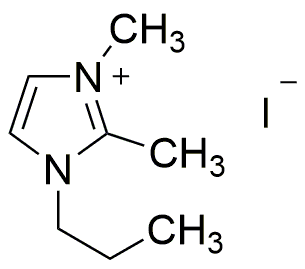1,2-Dimethyl-3-propylimidazolium iodide is widely utilized in research focused on:
- Electrolytes in Energy Storage: This compound serves as an effective electrolyte in lithium-ion batteries, enhancing their efficiency and longevity. Its ionic conductivity makes it a preferred choice for researchers looking to improve battery performance.
- Green Solvents: It acts as a green solvent in various chemical reactions, providing an environmentally friendly alternative to traditional solvents. This is particularly beneficial in the pharmaceutical industry, where reducing environmental impact is crucial.
- Catalysis: The compound is used as a catalyst in organic synthesis, facilitating reactions that are essential in producing fine chemicals and pharmaceuticals. Its unique structure allows for improved reaction rates and yields.
- Biocompatible Materials: In biomedical applications, it is explored for creating biocompatible materials, which can be used in drug delivery systems. This is vital for researchers developing targeted therapies.
- Corrosion Inhibition: It has potential as a corrosion inhibitor in various industrial applications, protecting metals from degradation. This application is particularly relevant in the oil and gas industry, where equipment longevity is critical.
General Information
Properties
Safety and Regulations
Applications
1,2-Dimethyl-3-propylimidazolium iodide is widely utilized in research focused on:
- Electrolytes in Energy Storage: This compound serves as an effective electrolyte in lithium-ion batteries, enhancing their efficiency and longevity. Its ionic conductivity makes it a preferred choice for researchers looking to improve battery performance.
- Green Solvents: It acts as a green solvent in various chemical reactions, providing an environmentally friendly alternative to traditional solvents. This is particularly beneficial in the pharmaceutical industry, where reducing environmental impact is crucial.
- Catalysis: The compound is used as a catalyst in organic synthesis, facilitating reactions that are essential in producing fine chemicals and pharmaceuticals. Its unique structure allows for improved reaction rates and yields.
- Biocompatible Materials: In biomedical applications, it is explored for creating biocompatible materials, which can be used in drug delivery systems. This is vital for researchers developing targeted therapies.
- Corrosion Inhibition: It has potential as a corrosion inhibitor in various industrial applications, protecting metals from degradation. This application is particularly relevant in the oil and gas industry, where equipment longevity is critical.
Documents
Safety Data Sheets (SDS)
The SDS provides comprehensive safety information on handling, storage, and disposal of the product.
Product Specification (PS)
The PS provides a comprehensive breakdown of the product’s properties, including chemical composition, physical state, purity, and storage requirements. It also details acceptable quality ranges and the product's intended applications.
Certificates of Analysis (COA)
Search for Certificates of Analysis (COA) by entering the products Lot Number. Lot and Batch Numbers can be found on a product’s label following the words ‘Lot’ or ‘Batch’.
*Catalog Number
*Lot Number
Certificates Of Origin (COO)
This COO confirms the country where the product was manufactured, and also details the materials and components used in it and whether it is derived from natural, synthetic, or other specific sources. This certificate may be required for customs, trade, and regulatory compliance.
*Catalog Number
*Lot Number
Safety Data Sheets (SDS)
The SDS provides comprehensive safety information on handling, storage, and disposal of the product.
DownloadProduct Specification (PS)
The PS provides a comprehensive breakdown of the product’s properties, including chemical composition, physical state, purity, and storage requirements. It also details acceptable quality ranges and the product's intended applications.
DownloadCertificates of Analysis (COA)
Search for Certificates of Analysis (COA) by entering the products Lot Number. Lot and Batch Numbers can be found on a product’s label following the words ‘Lot’ or ‘Batch’.
*Catalog Number
*Lot Number
Certificates Of Origin (COO)
This COO confirms the country where the product was manufactured, and also details the materials and components used in it and whether it is derived from natural, synthetic, or other specific sources. This certificate may be required for customs, trade, and regulatory compliance.


